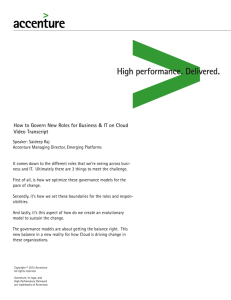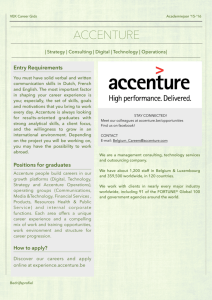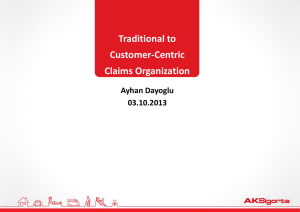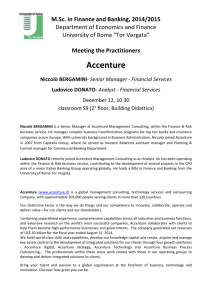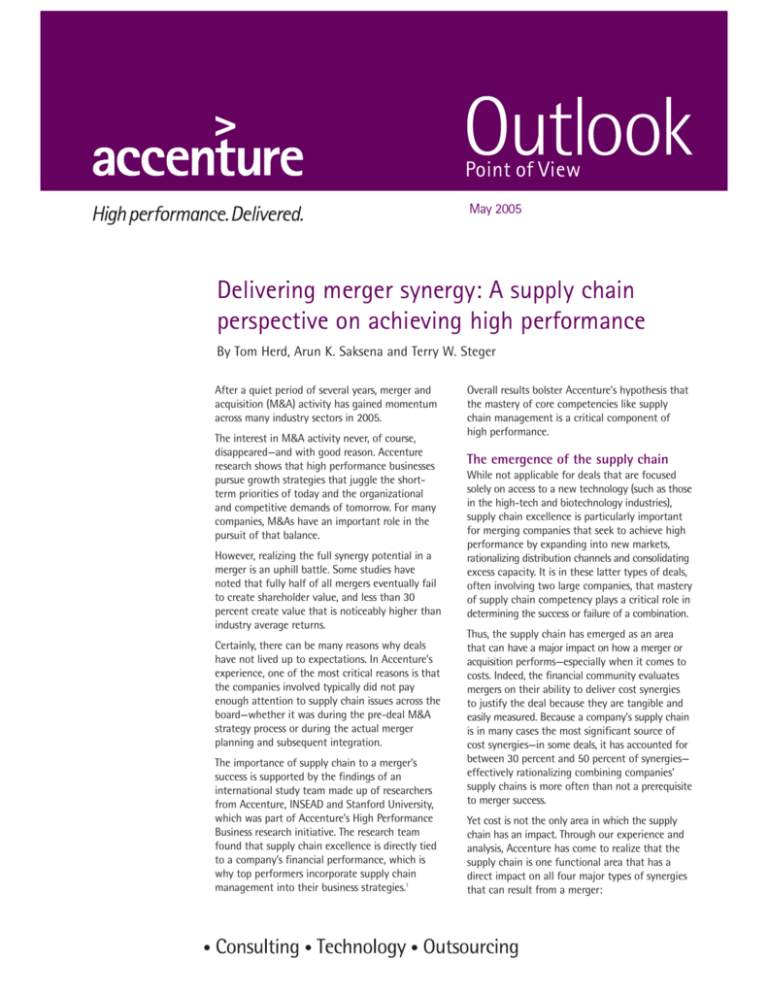
Point of View
May 2005
Delivering merger synergy: A supply chain
perspective on achieving high performance
By Tom Herd, Arun K. Saksena and Terry W. Steger
After a quiet period of several years, merger and
acquisition (M&A) activity has gained momentum
across many industry sectors in 2005.
The interest in M&A activity never, of course,
disappeared—and with good reason. Accenture
research shows that high performance businesses
pursue growth strategies that juggle the shortterm priorities of today and the organizational
and competitive demands of tomorrow. For many
companies, M&As have an important role in the
pursuit of that balance.
However, realizing the full synergy potential in a
merger is an uphill battle. Some studies have
noted that fully half of all mergers eventually fail
to create shareholder value, and less than 30
percent create value that is noticeably higher than
industry average returns.
Certainly, there can be many reasons why deals
have not lived up to expectations. In Accenture’s
experience, one of the most critical reasons is that
the companies involved typically did not pay
enough attention to supply chain issues across the
board—whether it was during the pre-deal M&A
strategy process or during the actual merger
planning and subsequent integration.
The importance of supply chain to a merger’s
success is supported by the findings of an
international study team made up of researchers
from Accenture, INSEAD and Stanford University,
which was part of Accenture’s High Performance
Business research initiative. The research team
found that supply chain excellence is directly tied
to a company’s financial performance, which is
why top performers incorporate supply chain
management into their business strategies.1
Overall results bolster Accenture’s hypothesis that
the mastery of core competencies like supply
chain management is a critical component of
high performance.
The emergence of the supply chain
While not applicable for deals that are focused
solely on access to a new technology (such as those
in the high-tech and biotechnology industries),
supply chain excellence is particularly important
for merging companies that seek to achieve high
performance by expanding into new markets,
rationalizing distribution channels and consolidating
excess capacity. It is in these latter types of deals,
often involving two large companies, that mastery
of supply chain competency plays a critical role in
determining the success or failure of a combination.
Thus, the supply chain has emerged as an area
that can have a major impact on how a merger or
acquisition performs—especially when it comes to
costs. Indeed, the financial community evaluates
mergers on their ability to deliver cost synergies
to justify the deal because they are tangible and
easily measured. Because a company’s supply chain
is in many cases the most significant source of
cost synergies—in some deals, it has accounted for
between 30 percent and 50 percent of synergies—
effectively rationalizing combining companies’
supply chains is more often than not a prerequisite
to merger success.
Yet cost is not the only area in which the supply
chain has an impact. Through our experience and
analysis, Accenture has come to realize that the
supply chain is one functional area that has a
direct impact on all four major types of synergies
that can result from a merger:
1. Revenue. A superior supply chain
protects revenue during times of
transition by ensuring customer orders
are not interrupted and by enabling an
organization to generate stronger topline growth in new products, new
markets and geographies.
2. Operating expense. How effectively the
company procures goods and services
and how efficiently the supply chain
runs has a direct impact on net income
and operating margins.
3. Capital expenditure. Because the supply
chain often accounts for a significant
portion of a company’s physical assets
(such as manufacturing plants, telecom
network assets, warehouses and truck
fleets), excellence in strategic sourcing
and supply chain operations can strongly
influence a company’s cash outflow.
4. Working capital. The supply chain’s
ability to quickly turn raw materials or
components into finished goods, get
those goods into customers’ hands, and
receive payment for those goods plays a
major role in a company’s cash position.
Supply chain merger synergies
While many business combinations
certainly have failed to live up to
expectations, other deals have delivered
promised benefits and resulted in a
stronger combined organization. In
studying numerous deals, Accenture
found that a major success factor is the
way the combining entities managed
supply chain issues throughout the
genesis, structuring and consummation
of the deal.
Accenture’s approach differs from others
in that it emphasizes bringing supply
chain and post-merger strategy
expertise together during the pre-deal
planning phase, rather than viewing
supply chain integration as a postmerger activity. While specific activities
will vary by company, this approach
encompasses several essential steps:
Identifying leadership and team. The
first step is actually taken by senior
management of the merging entities:
identifying the supply chain leadership
and establishing a supply chain functional
integration team with a clear charter
and scope.
Identifying synergies. Estimating the
value of synergies requires skillful
blending of “top-down” and “bottomup” methodologies. The deal execution
team should consider top-down industry
comparable benchmarks to determine
the magnitude of the overall
opportunity to reach industry-average
levels or better in a variety of key
operating metrics. The team should
supplement this effort with knowledge,
often provided from expert external
advisors, of synergy opportunities
achieved by comparable mergers. From
the bottom-up, the team should identify
specific opportunities, such as an
opportunity to consolidate a redundant
manufacturing facility for annual savings
of $100 million. By marrying the sum of
the bottom-up synergy summaries to
the top-down benchmarks, the company
can evaluate if the top-down estimates
are realistic—and if the due diligence
teams have been aggressive enough in
outlining specific opportunities before
making the announcement.
Determining requirements. The third
important task the supply chain team
must conduct is determining Day 0/
Day 1/Day 100 requirements specifically
for the supply chain. Day 0 is defined as
the target date when the deal is
expected to be approved by the
government’s regulatory body, while
Day 1 is a date established by senior
management when the two merging
companies are expected to begin
operating as one integrated enterprise. It
is critical to minimize the gap between
Day 0 and Day 1. By identifying the
specific supply chain initiatives that must
be undertaken to deliver planned cost
and revenue synergies—and prioritizing
these initiatives on the basis of ease of
implementation and speed at which they
will create value—the team can help
ensure that the merged organization is
ready to begin generating value
immediately upon closure of the deal.
Developing metrics. Finally, the team
must develop a set of supply chain
merger integration success metrics. Such
metrics help the newly integrated supply
chain organization gauge the success of
merger integration, as well as keep the
team focused on the most important
priorities. Importantly, these metrics may
be different from those typically used in
internal supply chain scorecards, which
measure and track the efficiency and
effectiveness of internal steady-state
operations. Key integration success metrics
include percentage of Day 0/Day 1
requirements successfully met on time
and the number of contracts re-priced
and re-negotiated for cost savings.
Achieving high performance
As more companies increasingly depend
on combinations to fuel a larger portion
of their growth, it becomes even more
critical for those deals to be successful
and to deliver the promised synergies.
Recognizing that the supply chain plays
a critical role in the success of any
deal—and indeed is fundamental to
achieving high performance of the
expanded company—can help ensure
that the transition in this key functional
area goes smoothly. This recognition in
turn can help increase the chances that
customers, shareholders and Wall Street
will feel as good about the new entity a
year after the merger as the constituent
organizations’ senior executives did the
day it was announced.
Tom Herd, associate partner-Accenture
Merger & Acquisition and Corporate
Strategy group, has 10 years of
management consulting experience in
M&A, merger integration and strategy
consulting. He can be reached at
thomas.j.herd@accenture.com.
Arun K. Saksena, associate partnerAccenure Supply Chain Management,
assists companies in the communications
and high-tech industries with supply chain
transformation, product development
and strategic sourcing to help them
improve their performance. He can be
reached at arun.k.saksena@accenture.com.
Terry W. Steger, senior manager-Accenture
Supply Chain Management, helps
communications, high-tech, and media
and entertainment companies design
and implement major change initiatives
in procurement, supply chain and service
management operations. He can be
reached at terry.w.steger@accenture.com
The full report, “Connecting with the
Bottom Line: A Global Study of Supply
Chain Leadership and Its Contribution to
the High-Performance Supply Business” is
available at www.accenture.com/supplychain.
1
Accenture is a global management consulting,
technology services and outsourcing company.
Committed to delivering innovation,
Accenture collaborates with its clients to
help them become high-performance
businesses and governments. Its home page
is www.accenture.com.
The views and opinions expressed in this
article are meant to stimulate thought and
discussion. As each business has unique
requirements and objectives, these ideas
should not be viewed as professional advice
with respect to your business.
Copyright © 2005 Accenture.
All rights reserved.
Accenture, its logo, and
High Performance Delivered
are trademarks of Accenture.


